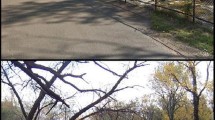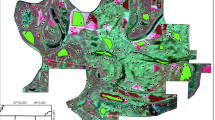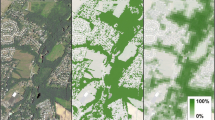Abstract
Riparian areas contain structurally diverse habitats that are challenging to monitor routinely and accurately over broad areas. As the structural variability within riparian areas is often indiscernible using moderate-scale satellite imagery, new mapping techniques are needed. We used high spatial resolution satellite imagery from the QuickBird satellite to map harvested and intact forests in coastal British Columbia, Canada. We distinguished forest structural classes used in riparian restoration planning, each with different restoration costs. To assess the accuracy of high spatial resolution imagery relative to coarser imagery, we coarsened the pixel resolution of the image, repeated the classifications, and compared results. Accuracy assessments produced individual class accuracies ranging from 70 to 90% for most classes; whilst accuracies obtained using coarser scale imagery were lower. We also examined the implications of map error on riparian restoration budgets derived from our classified maps. To do so, we modified the confusion matrix to create a cost error matrix quantifying costs associated with misclassification. High spatial resolution satellite imagery can be useful for riparian mapping; however, errors in restoration budgets attributable to misclassification error can be significant, even when using highly accurate maps. As the spatial resolution of imagery increases, it will be used more routinely in ecosystem ecology. Thus, our ability to evaluate map accuracy in practical, meaningful ways must develop further. The cost error matrix is one method that can be adapted for conservation and planning decisions in many ecosystems.




Similar content being viewed by others
References
Apan AA, Raine SR, Paterson MS. 2002. Mapping and analysis of changes in the riparian landscape structure of the Lockyer Valley catchment, Queensland, Australia. Landscape Urban Plan 59:43–57
Baatz M., Benz U, Dehghani S, Heynen M, Holtje A, Hofmann P, Lingenfelder I., Mimler M, Sohlbach M, Weber M, Willhauck G. 2004. ECognition professional: User guide definens-imaging, Munich
Baker ME, Weller DE, Jordan TE. 2006. Improved methods for quantifying potential nutrient interception by riparian buffers. Landscape Ecol 21:1327–45
Bernhardt ES, Palmer MA, Allan JD, Alexander G, Barnas K, Brooks S, Carr J, Clayton S, Dahm C, Follstad-Shah J, Galat D, Gloss S, Goodwin P, Hart D, Hassett B, Jenkinson R, Katz S, Kondolf GM, Lake PS, Lave R, Meyer JL, O’Donnell TK, Pagano L, Powell B, Sudduth E. 2005. Ecology—synthesizing US river restoration efforts. Science 308:636–7
Bilby RE, Ward JW. 1991. Characteristics and function of large woody debris in streams draining old-growth, clear-cut, and 2nd-growth forests in southwestern Washington. Can J Fish Aquat Sci 48:2499–508
British Columbia Ministry of Forests. 2001. Mensuration data from the Provincial Ecology Program. British Columbia Ministry of Forests, Victoria
Bryant RG, Gilvear DJ. 1999. Quantifying geomorphic and riparian land cover changes either side of a large flood event using airborne remote sensing: River Tay, Scotland. Geomorphology 29:307–321
Chubey MS, Franklin SE, Wulder MA. 2006. Object-oriented analysis of Ikonos-2 imagery for extraction of ofrest inventory parameters. Photogramm Eng Remote Sensing 72:383–394
Clark DB, Read JM, Clark ML, Cruz AM, Dotti MF, Clark DA. 2004. Application of 1-M and 4-M resolution satellite data to ecological studies of tropical rain forests. Ecol Appl 14:61–74
Clayoquot Sound Scientific Panel. 1995. Report 5: sustainable ecosystem management in clayoquot sound. Halfmoon Bay, British Columbia
Congalton RG, Birch K, Jones R, Schriever J. 2002. Evaluating remotely sensed techniques for mapping riparian vegetation. Comput Electron Agri 37:113–26
de Kok R, Schneider T, Ammer U. 1999. Object-oriented classification and applications in the alpine forest environment. Int Arch Photogramm Remote Sensing, vol. 32
Dussault C, Courtois R, Huot J, Ouellet JP. 2001. The use of forest maps for the description of wildlife habitats: limits and recommendations. Can J For Res 31:1227–34
Ehlers M, Gahler M, Janowsky R. 2003. Automated analysis of ultra high resolution remote sensing data for biotope type mapping: new possibilities and challenges. J Photogramm Remote Sensing 57:315–26
Ellison AM, Bank MS, Clinton BD, Colburn EA, Elliott K, Ford CR, Foster DR, Kloeppel BD, Knoepp JD, Lovett GM, Mohan J, Orwig DA, Rodenhouse NL, Sobczak WV, Stinson KA, Stone JK, Swan CM, Thompson J, Von Holle B, Webster JR. 2005. Loss of foundation species: consequences for the structure and dynamics of forested ecosystems. Frontiers Ecol Environ 3:479–86
Fetherston KL, Naiman RJ, Bilby RE. 1995. Large woody debris, physical process, and riparian forest development in montane river networks of the Pacific-Northwest. Geomorphology 13:133–44
Foody GM. 2002. Status of land cover classification accuracy assessment. Remote Sensing Environ 80:185–201
Franklin JF, Dyrness CT. 1973. The natural vegetation of Washington and Oregon. Oregon State University Press, Corvallis
Franklin JF, Spies TA, Van Pelt R, Carey AB, Thornburgh DA, Berg DR, Lindenmayer DB, Harmon ME, Keeton WS, Shaw DC, Bible K, Chen JQ. 2002. Disturbances and structural development of natural forest ecosystems with silvicultural implications, using Douglas-fir forests as an example. Forest Ecol Manage 155:399–423
Gavin DG, Brubaker LB, Lertzman KP. 2003a. An 1800-year record of the spatial and temporal distribution of fire from the west coast of Vancouver Island, Canada. Can J For Res 33:573–86
Gavin DG, Brubaker LB, Lertzman KP. 2003b. Holocene fire history of a coastal temperate rainforest based on soil charcoal radiocarbon dates. Ecology 84:186–201
Gergel SE. 2007. New directions in landscape pattern analysis and linkages with remote sensing in Wulder MA, Franklin SE, Eds. Remote Sensing Spatial Pattern. New York: CRC/Taylor & Francis
Goetz SJ. 2006. Remote sensing of riparian buffers: Past progress and future prospects. J Am Water Resour Assoc 42:133–43
Goetz SJ, Wright RK, Smith AJ, Zinecker E, Schaub E. 2003. IKONOS imagery for resource management: tree cover, impervious surfaces, and riparian buffer analyses in the mid-Atlantic region. Remote Sensing Environ 88:195–208
Hay GJ, Castilla G, Wulder MA, Ruiz JR. 2005. An automated object-based approach for the multiscale image segmentation of forest scenes. Int J Appl Earth Observ Geoinformat 7:339–59
Hlavka CA, Livingston GP. 1997. Statistical models of fragmented land cover and the effect of coarse spatial resolution on the estimation of area with satellite sensor imagery. Int J Remote Sensing 18:2253–9
Hyatt TL, Waldo TZ, Beechie TJ. 2004. A watershed scale assessment of riparian forests, with implications for restoration. Restoration Ecol 12:175–183
Johansen K, Coops NC, Gergel SE, Stange Y. in Press. Application of high spatial resolution satellite imagery for riparian ecosystem classification. Remote Sensing Environ.
Johansen K, Phinn S. 2006. Linking riparian vegetation structure in Australian tropical savannas to ecosystem health indicators: semi-variogram analysis of high spatial resolution satellite imagery. Can J Remote Sensing 32:228–43
Langford WT, Gergel SE, Dietterich TG, Cohen W. 2006. Map misclassification can cause large errors in landscape pattern indices: Examples from habitat fragmentation. Ecosystems 9:474–88
Lertzman KP, Sutherland GD, Inselberg A, Saunders SC. 1996. Canopy gaps and the landscape mosaic in a coastal temperate rainforest. Ecology 77:1254–70
Lillesand TM, Kiefer RW, Chipman JW. 2004. Remote sensing and image interpretation, 5th Edn. New York: Wiley
MacKinnon A. 2003. West coast, temperate, old-growth forests. For Chronicle 79:475–84
McKeown DM. 1988. Building knowledge-based systems for detecting man-made structures from remotely sensed imagery. Philos Trans R Soc London Series A—Math Phys Eng Sci 324:423
Morgan JL, Gergel SE, Coops NC, Bater CW, in Review. Mapping high quality fish habitat using high spatial resolution imagery. Remote Sensing Environ.
Muller E. 1997. Mapping riparian vegetation along rivers: old concepts and new methods. Aquatic Botany 58:411–37
Naiman RJ, Decamps H. 1997. The ecology of interfaces: Riparian zones. Annu Rev Ecol Systemat 28:621–58
Naiman RJ, Decamps H, Pollock M. 1993. The role of riparian corridors in maintaining regional biodiversity. Ecol Appl 3:209–12
Naiman RJ, Bilby RE, Bisson PA. 2000. Riparian ecology and management in the Pacific Coastal Rain Forest. Bioscience 50:996–1011
Neale CMU. 1997. Classification and mapping of riparian systems using airborne multispectral videography. Restoration Ecol 5:103–12
Pojar J, Klinka K, Meidinger DV. 1987. Biogeoclimatic ecosystem classification in British Columbia. Forest Ecol Manage 22:119–54
Pojar J, Klinka K, Demarchi DA. 1991. Coastal western hemlock zone. Special report series 6: ecosystems of British Columbia. British Columbia Ministry of Forests, Victoria, British Columbia
Pontius RG. 2002. Statistical methods to partition effects of quantity and location during comparison of categorical maps at multiple resolutions. Photogrammet Eng Remote Sensing 68:1041–9
Pontius RG, Lippitt CD. 2006. Can error explain map differences over time? Cartography Geographic Informat Sci 33:159–171
Poulin VA, Simmons B. 2001. Lost Shoe Creek riparian assessment and recommendations for riparian restoration. Poulin & Associates, Ltd and Quillicum Environmental Services, Ltd
Poulin VA, Harris C, Simmons B. 2000. Riparian restoration in British Columbia: What’s happening now, what’s needed for the future. Prepared for BC Ministry of Forests, Victoria, British Columbia
Pouliot DA, King DJ, Pitt DG 2006. Automated assessment of hardwood and shrub competition in regenerating forests using leaf-off airborne imagery. Remote Sensing Environ 102:223–36
RSI. 2005. ENVI Version 4.2. Boulder, USA
Swanson FJ, Franklin JF 1992. New forestry principles from ecosystem analysis of Pacific-Northwest forests. Ecol Appl 2:262–74
Tanaka S, Sugimura T 2001. A new frontier of remote sensing from IKONOS images. Int J Remote Sensing 22:1–5
Tockner K, Stanford JA 2002. Riverine flood plains: present state and future trends. Environ Conserv 29:308–30
Trodd NM. 1995. Uncertainty in land cover mapping for modelling land cover change. Proceedings of RSS95: Remote Sensing in Action. Remote Sensing Society, Nottingham. pp. 1138–45
Trofymow JA, MacKinnon A, Eds. 1998. Special issue on structure, process, and diversity in successional forests of coastal British Columbia. Northwest Sci 72:1–3
Visser H, de Nijs T 2006. The map comparison kit. Environ Model Software 21:346–58
Weller DE, Jordan TE, Correll DL 1998. Heuristic models for material discharge from landscapes with riparian buffers. Ecol Appl 8:1156–69
Wilen BO, Bates MK 1995. The US Fish and Wildlife Service’s National Wetlands Inventory Project. Vegetatio 118:153–169
Wulder MA, Hall RJ, Coops NC, Franklin SE 2004. High spatial resolution remotely sensed data for ecosystem characterization. Bioscience 54:511–521
Acknowledgments
This research, including funds for YS and KK, was funded by the BC Ministry of Forests and Range and NSERC Discovery grants to SEG. KJ was supported by Tropical Savannas CRC and a University of Queensland Graduate School Research Travel Award. D. Collins, A. MacKinnon, Parks Canada staff at Pacific Rim National Park, our field crew, S. Agbayani, W. Warttig, and S. Thompson deserve thanks for their assistance. Two anonymous reviewers provided detailed comments that significantly improved this manuscript.
Author information
Authors and Affiliations
Corresponding author
Rights and permissions
About this article
Cite this article
Gergel, S.E., Stange, Y., Coops, N.C. et al. What is the Value of a Good Map? An Example Using High Spatial Resolution Imagery to Aid Riparian Restoration. Ecosystems 10, 688–702 (2007). https://doi.org/10.1007/s10021-007-9040-0
Published:
Issue Date:
DOI: https://doi.org/10.1007/s10021-007-9040-0




